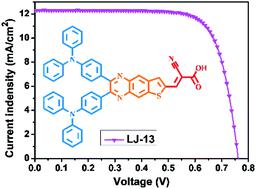当前位置:
X-MOL 学术
›
Sustain. Energy Fuels
›
论文详情
Our official English website, www.x-mol.net, welcomes your
feedback! (Note: you will need to create a separate account there.)
A facile approach to construct organic D–π–A dyes via sequential condensation reactions for dye-sensitized solar cells
Sustainable Energy & Fuels ( IF 5.0 ) Pub Date : 2020-11-18 , DOI: 10.1039/d0se01519a Hongjin Chen 1, 2, 3, 4, 5 , Ashraful Islam 6, 7, 8, 9 , Towhid H. Chowdhury 6, 7, 8, 9 , Idriss Bedja 10, 11, 12, 13, 14 , Hamid M. Ghaithan 10, 11, 12, 13, 14 , Rui Zhang 1, 2, 3, 4, 5 , Jian Liu 1, 2, 3, 4, 5
Sustainable Energy & Fuels ( IF 5.0 ) Pub Date : 2020-11-18 , DOI: 10.1039/d0se01519a Hongjin Chen 1, 2, 3, 4, 5 , Ashraful Islam 6, 7, 8, 9 , Towhid H. Chowdhury 6, 7, 8, 9 , Idriss Bedja 10, 11, 12, 13, 14 , Hamid M. Ghaithan 10, 11, 12, 13, 14 , Rui Zhang 1, 2, 3, 4, 5 , Jian Liu 1, 2, 3, 4, 5
Affiliation

|
We developed a new strategy for the molecular engineering of organic D–π–A sensitizers for dye-sensitized solar cell (DSSC) applications. Different from the synthesis of organic D–π–A dyes by conventional C–C coupling method, the present approach highlights the construction of D–π–A backbone via sequential condensation reactions. This approach avoids noble metal catalysis as well as harsh reaction conditions. Based on this concept, four organic D–π–A dyes have been developed as sensitizers for DSSCs, which produced high IPCE values and photovoltage. Moreover, expansion of the π-conjugated spacer in this type of dyes resulted in enhanced photovoltaic performance, which provided a new pathway for designing D–π–A dyes.
中文翻译:

通过顺序缩合反应为染料敏化太阳能电池构建有机D–π–A染料的简便方法
我们开发了一种用于染料敏化太阳能电池(DSSC)应用的有机D-π-A敏化剂分子工程的新策略。与通过常规C–C偶联方法合成有机D–π–A染料不同,本方法强调了通过顺序缩合反应构建D–π–A主链的方法。这种方法避免了贵金属催化以及苛刻的反应条件。基于此概念,已开发出四种有机D–π–A染料作为DSSC的敏化剂,它们产生了很高的IPCE值和光电压。此外,这种类型的染料中π共轭间隔基的扩展导致增强的光伏性能,这为设计D–π–A染料提供了新途径。
更新日期:2020-11-27
中文翻译:

通过顺序缩合反应为染料敏化太阳能电池构建有机D–π–A染料的简便方法
我们开发了一种用于染料敏化太阳能电池(DSSC)应用的有机D-π-A敏化剂分子工程的新策略。与通过常规C–C偶联方法合成有机D–π–A染料不同,本方法强调了通过顺序缩合反应构建D–π–A主链的方法。这种方法避免了贵金属催化以及苛刻的反应条件。基于此概念,已开发出四种有机D–π–A染料作为DSSC的敏化剂,它们产生了很高的IPCE值和光电压。此外,这种类型的染料中π共轭间隔基的扩展导致增强的光伏性能,这为设计D–π–A染料提供了新途径。











































 京公网安备 11010802027423号
京公网安备 11010802027423号